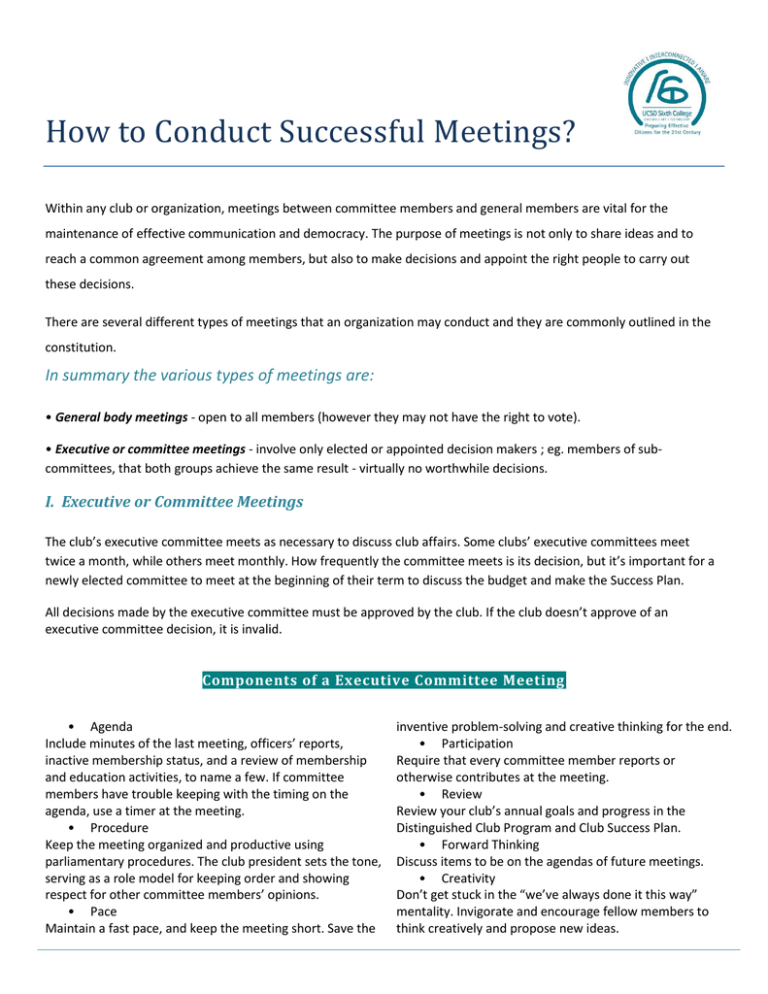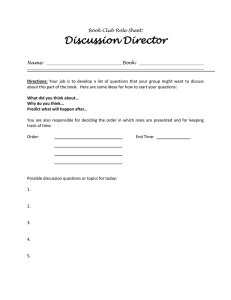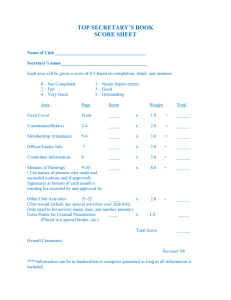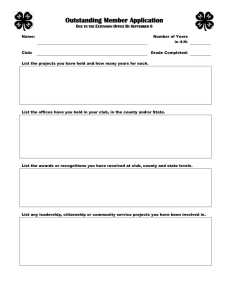How to Conduct Successful Meetings?
advertisement

How to Conduct Successful Meetings? Within any club or organization, meetings between committee members and general members are vital for the maintenance of effective communication and democracy. The purpose of meetings is not only to share ideas and to reach a common agreement among members, but also to make decisions and appoint the right people to carry out these decisions. There are several different types of meetings that an organization may conduct and they are commonly outlined in the constitution. In summary the various types of meetings are: • General body meetings - open to all members (however they may not have the right to vote). • Executive or committee meetings - involve only elected or appointed decision makers ; eg. members of subcommittees, that both groups achieve the same result - virtually no worthwhile decisions. I. Executive or Committee Meetings The club’s executive committee meets as necessary to discuss club affairs. Some clubs’ executive committees meet twice a month, while others meet monthly. How frequently the committee meets is its decision, but it’s important for a newly elected committee to meet at the beginning of their term to discuss the budget and make the Success Plan. All decisions made by the executive committee must be approved by the club. If the club doesn’t approve of an executive committee decision, it is invalid. Components of a Executive Committee Meeting • Agenda Include minutes of the last meeting, officers’ reports, inactive membership status, and a review of membership and education activities, to name a few. If committee members have trouble keeping with the timing on the agenda, use a timer at the meeting. • Procedure Keep the meeting organized and productive using parliamentary procedures. The club president sets the tone, serving as a role model for keeping order and showing respect for other committee members’ opinions. • Pace Maintain a fast pace, and keep the meeting short. Save the inventive problem-solving and creative thinking for the end. • Participation Require that every committee member reports or otherwise contributes at the meeting. • Review Review your club’s annual goals and progress in the Distinguished Club Program and Club Success Plan. • Forward Thinking Discuss items to be on the agendas of future meetings. • Creativity Don’t get stuck in the “we’ve always done it this way” mentality. Invigorate and encourage fellow members to think creatively and propose new ideas. II. General Body Meetings (with more details and procedures about me etings) Many clubs have a meeting time which has been etched in tradition, for example 7.30pm at the lodge on the first Wednesday of each month. In this case, there is no need to send out reminder notices. Whatever the tradition it is better to keep matters formal. The club secretary should issue a notice of the meeting attaching the agenda, minutes of the last meeting, the financial statement (if any) and written material related to important items due to be considered at the meeting. MEETING PROCEDURES If a club follows the correct procedures for a meeting, they will tend to flow smoothly, run on time and be an effective and fair source for decision making. In some cases there are no defined procedures at all and in other cases the procedures are defined and restrictive. Meeting procedures are set up to: • Improve the efficiency in the conduct of the business of the meeting while giving protection to the rights of members present. • Enable every person in the meeting to have an equal right to be heard and to have the opportunity to have their viewpoint considered. • Enable every person present to have an equal right to vote on the issues and to help in the decision making. Make sure that your club members are aware of the meeting procedures and kept informed of any changes. PRIOR TO THE MEETING • Make arrangements for the meeting place. • Send adequate notice of the meeting to all concerned. • Minutes of the previous meeting should be enclosed if they have not already been sent. (More as needed) • Collecting reports from club officers. • Advising members of the meeting within a specified time. • Calling for and receiving nominations for club positions. • Arranging for printing of the completed annual report. • Arranging for guest speakers. • Arranging hospitality, venue, date and times Agenda The agenda should be detailed enough to allow all those attending the meeting to arrive fully informed and prepared. Where possible ensure supporting papers/notes accompany the agenda. Elements of an agenda are shown below – 1. Opening Formalities 11. Election of Office Bearers 2. Apologies 12. Election of Auditor 3. Confirmation of Minutes 13. Guest Speaker 4. Business Arising from the Minutes 14. Motions on Notice 5. Correspondence 15. General Business 6. Business Arising from the Correspondence 16. Notice of Motions 7. President's Report 17. New Business 8. Treasurer's Report 18. Date of Next Meeting 9. Approval of Memberships 19. Close of Meeting 10. Special Reports AT THE MEETING Meeting procedures may vary according to the level of formality required to complete the agenda efficiently. A small club might be able to dispense with the more formal agendas required by a national organization. Most people have experience with meetings. Often the constitution of clubs will give guidelines on how meetings are to be called and managed. For formal meetings, Rules of Debate can be used. These are guidelines based on Parliamentary procedure and apply to general meetings of members and public meetings. Formal procedure gives meetings a structure and helps members reach clear decisions. They can also help control large meetings or a single antagonist on a committee. Motions The Rules of Debate require that all business be put forward as a positive statement of action called a “motion”. A motion is a formal recommendation put to a meeting for debate and consideration. Understanding Motions All items of business or issues requiring a decision must be presented to the meeting as motions which if passed, will then become resolutions. All motions should be proposed by the “mover” in front of the chairperson and then supported (seconded) by another committee member before any discussion can take place on the item. Example: “Club fees should be increased by 15% next year”. The proposer then explains the motion to support it. The seconder has the right to speak immediately or wait till the end of the debate. The chairperson then calls for speakers alternately for and against the motion. At the end of the debate, the proposer can reply. A vote is taken. The secretary should record the motion, who proposed and seconded it and whether it was carried. Amendments Any speaker can move an amendment to the motion. When this happens, people speak for and against the amended motion. The amendment must be put before voting on the original motion. If the amended motion is carried, the debate continues on the amended motion. If the amended motion is lost, discussion moves back to the original motion. CHAIRING MEETINGS Throughout the meeting the chairperson: • Notes who wishes to speak, and indicates when a person may speak. • Is responsible for keeping conversation to the subject. • Decides when discussion should be brought to an end. • Does not usually get involved in the discussion unless their opinion is sought. • Should summarize the issue under discussion to aid in decision making. • If it is apparent that a decision cannot be made - refer the item to a working group for a report at the next meeting. VOTING AT MEETINGS The chairperson must have a clear understanding of the voting rights of members (see your club’s constitution). There are several ways of voting. Choose the one most appropriate to your situation - don’t opt for a secret ballot when you know everyone in the room agrees on an issue. • General agreement - why put it to the vote if it seems everyone is in agreement? The chairperson can say “Do we all agree that...? Does anyone disagree?” • Verbal - the chairperson asks people to say “yes” or “no” and decides which was the louder response. Suitable for larger groups. • Show of Hands - the chairperson asks people to raise their hand to either “yes” or “no” and counts the hands. This is useful where a precise vote count is required. • Individual vote - the chairperson asks each person to turn for their view. This is better suited to small groups - it prevents anyone from fence-sitting. • Secret ballot - individuals vote on paper and two elected people - often committee members - count the votes. Suitable for elections. • Proxy - individuals who are absent can give someone else the power to cast their vote. Proxy votes are permitted only if the constitution allows for them and are usually bound by strict rules to prevent unfair lobbying, eg. votes may be cast only in writing a week in advance. • Postal - again, these are only permitted if the constitution allows them. AFTER THE MEETING For the sake of accuracy, minutes should be written as soon after the meeting as possible, when the details are still fresh in the mind. Preferably minutes should be circulated within a week of the meeting being held. Prompt circulation of the minutes stirs people who have been assigned tasks into early action and swiftly brings up to date those who missed the meeting. Note points for action (and the person responsible) that need to be chased up between meetings. Make a note of diary items requiring long-term attention. TAKING MINUTES • List those present along with apologies given. • Follow the order of the agenda. This can be varied to suit a particular situation. • State the main issues, points of view put forward, and decisions made. • Make sure the full texts of motions are recorded. • List accounts for payment approved, reports received, main points of answers required for correspondence, etc. • Be alert to take extra notes that may be needed by the chairperson. • Write up minutes as soon as possible after the meeting. An example of what is required to be placed on posters to inform people of a meeting. EXAMPLE ONLY NOTICE OF MEETING The next meeting of the Video Production Club will be held on: Wednesday 27 March 2013 at 3.00pm in the Center Hall 115 If you are unable to attend please contact John on (858)-345-XXXX Adapted from USQ Student Guild, Toastmasters International.


